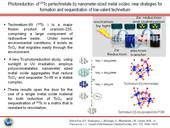Highlight
Photoreduction of 99Tc pertechnetate by nanometer-sized metal oxides: new strategies for formation and sequestration of low-valent technetium
Achievement/Results
Photoreduction of 99Tc pertechnetate by nanometer-sized metal oxides: new strategies for formation and sequestration of low-valent technetium Burton-Pye, B.P.; Radivojevic, I.; McGregor, D.; Mbomekalle, I.M.; Lukens, W.W., Jr.; Francesconi, L.C.
Technetium-99 (99Tc) (β-max: 293.7 keV; t½: 2.1 × 105 years) is a byproduct of uranium-235 fission and comprises a large component of radioactive waste. Under aerobic conditions and in a neutral- basic environment, the pertechnetate anion (TcO4-) is stable. TcO4- is very soluble, migrates easily through the environment and does not sorb well onto mineral surfaces, soils or sediments. This study moves forward a new strategy for the reduction of TcO4- and chemical incorporation of the reduced Tc into a metal oxide material. this approach involves the employment of a single material to both reduce pertechnetate and then covalently incorporate the low valent Tc into the metal oxide framework.
Also, we strive to achieve a molecular – level understanding of the processes by monitoring the chemistry with species-specific techniques, such as multinuclear NMR, X-ray Absorption Spectroscopy to identify the dynamic process and the intermediate and final species. This strategy employs a single material, a polyoxometalate (POM), α2-[P2W17O61]10-, that can be photoactivated in the presence of 2-propanol to transfer electrons to TcO4-, and incorporate the reduced Tc covalently into the α2- framework to form the TcVO species, TcVO(α2-P2W17O61)7-. This occurs via the formation of an intermediate species that slowly converts to TcVO(α2-P2W17O61)7-. EXAFS and XANES analysis suggests that the intermediate consists of a Tc(IV) α2- species where the Tc is likely bound to only 2 of the 4 W-O oxygen atoms in the α2-[P2W17O61]10- defect. This intermediate then oxidizes and converts to the TcVO(α2-P2W17O61)7- product. The reduction and incorporation of TcO4- was accomplished in a “one pot” reaction using both sunlight and UV irradiation, and monitored as a function of time using multinuclear NMR and radio TLC.
The process was further probed by the “step-wise” generation of reduced 2-P2W17O6112- through bulk electrolysis followed by the addition of TcO4-. The reduction and incorporation of ReO4-, as a non-radioactive surrogate for 99Tc, does not proceed through the intermediate species, and ReVO is incorporated quickly into the α2-[P2W17O61]10- defect. These observations are consistent with the periodic trends of Tc and Re. Specifically, Tc is more easily reduced compared to Re. Impact: This study opens the door for the use of metal oxide materials for reduction of TcO4- and incorporation of the reduced Tc covalently into the material. This procedure ensures that the reduced Tc is in a stable metal oxide environment and not prone to oxidation back to TcO4- . Another significant point is the demonstration of the sometimes significant differences in the chemistry of Tc and Re, often considered a non-radioactive surrogate for Tc.
Address Goals
This activity presents a new strategy and new way of thinking about environmental remediation of the element technetium-99. This is a most problematic isotope in the nuclear fuel cycle and is present in radioactive waste tanks from the defense activities of the 1940-1950s. Presently remediation efforts do not take into account the complicated redox chemistry of the element. This activity “advances the frontiers of knowledge” by presenting the approach that one material can both reduce pertechnetate and incorporate the reduced Tc directly into the material.
this activity also expands the awareness and scientific literacy of chemists primarily to the issues and problems of the element technetium-99 as well as other radioactive elements that are products of Uranium 235 fission.






